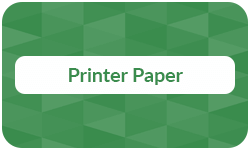
Printer paper is something that most of us use every single day or every other day without thinking twice about it. Whether you’re printing documents, school assignments, or colorful flyers, the quality, and type of paper you choose can make a big difference. In this article, we’ll give you a simple overview of what printer paper is, what makes it unique, and why it matters, without getting too technical with our explanations.
Definition: Printer paper
At its core, printer paper — also copy paper or printing paper — is specially manufactured to work well with specific types of printers, whether inkjet, laser, or multifunction devices. It’s designed to absorb printing ink or toner evenly, which ensures sharp prints without smudging or bleeding. But not all paper is created equal, as printer paper has specific characteristics that set it apart from other paper types.
Your guide to print and production
- Information on printing processes & print production
- Information on materials & optimal use of materials
- Information on print finishing & print processing
Learn more!
Common characteristics
While printer paper may look like any other stack of white sheets, it actually has certain qualities that make it ideal for printing. Here’s a quick look at the most important characteristics, from size and weight to texture and brightness. We’ll just cover the basics here — you can dive deeper in our dedicated articles.
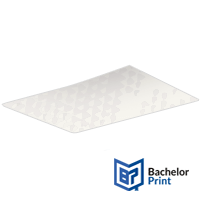
Paper surface
The surface of printer paper is a general term that refers to how smooth or textured the physical outer layer of the paper feels. A smoother surface usually results in sharper prints because the ink or toner can sit evenly on the page. Rougher paper, on the other hand, may cause ink to spread or appear less defined.

Paper type
Printer paper comes in different types, such as standard copy paper, premium paper, photo paper, or recycled paper. Each type of printer paper is designed for specific printing needs, whether that be text documents, high-quality images, or eco-friendly projects.
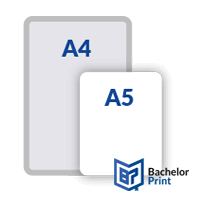
Paper size
Paper size defines the dimensions of each sheet and ranges from A1 (the biggest) to A10 (the smallest). The most common size is the A4 paper dimension, which comes in many different weights and coatings, making it suitable for any printing job. There are other sizes as well, such as the US paper size Letter, which is used in North America.
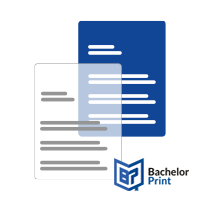
Paper opacity
Opacity in terms of paper refers to how much light passes through it, basically how “see-through” it is. This affects double-sided printing and, of course, the overall print visibility. Higher opacity means less transparency, which is important to avoid text or images showing through.
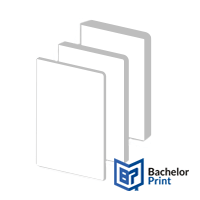
Paper weight
Paper weight refers to how thick and heavy the paper is, which is usually measured in GSM (grams per square meter) or lb (pounds). Heavyweight paper feels sturdier and is often used for professional documents — such as dissertation printing — while lightweight paper is more economical for everyday printing.
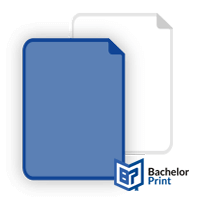
Paper coating
Some printer paper is coated with a special layer — such as white clay or calcium carbonate. This coating improves ink holdout, meaning the ink stays on the surface rather than soaking into the paper fibers. Coated paper is often used for printing photos or vibrant graphics, while uncoated paper has a more natural, matte finish and is ideal for everyday printing. There are three degrees of smoothness and density in technical coating terms: dull, matte, and gloss coating.
A dense surface (glossy paper) reflects light more evenly, but can tire the reader’s eyes. A dull coating has a softer sheen and is slightly less smooth, while a soft surface (matte paper) has the least reflectivity and a more textured surface, making it easier to read and cheaper to produce.
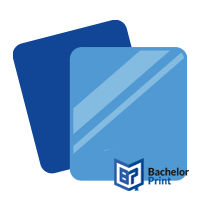
Paper finish
Paper finish describes the texture and sheen of the paper’s surface. Common finishes include glossy, matte, and textured (e.g., linen paper). Satin or semi-gloss finishes offer a balance between glossy and matte to provide some vibrancy without the high gloss. Unlike coated paper, coating finish is a clear layer applied after the ink is printed on the paper. It adds a higher level of protection from scratches and fingerprints, while also significantly enhancing the visibility of graphics and durability of brochures, flyers, etc., during and after shipment.
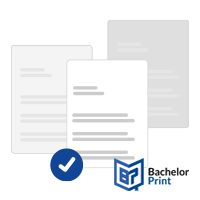
Paper brightness
Paper brightness refers to how much light the paper reflects. It is measured on a scale from 0 to 100 — the higher the number, the brighter and whiter the paper appears. Brightness impacts the contrast of printed content; higher brightness (90-100) makes colors appear more vibrant and text more defined. Standard brightness (80-89) is commonly used for everyday printing needs and offers a balanced look on paper. Lower brightness paper (70-79) makes it easier on the eyes for reading large amounts of text. However, brightness is not the same as whiteness because whiteness refers to the shade of white (cool, neutral, or warm) while brightness is measured under specific lighting conditions.
Printing services at BachelorPrint
- Wide range of print products for every need
- Individual solutions & personal support
- High print quality & fast production times
Learn more!
Why does printer paper matter?
You might think any paper will do when it comes to printing, but the reality is that the paper you use affects the final result more than you realize. Good printer paper can improve print quality, prevent jams, and even save you money eventually. Here’s why paying attention to printer paper is worth it.
- Print quality: Choosing the right printing paper impacts print quality, meaning high-quality paper can make your text, images, and colors sharper and more vibrant. The characteristics mentioned above all influence how your text and images appear on the page.
- Fewer paper jams: Using the wrong type of printer paper can result in frequent paper jams, thus wasting a lot of precious time. Manufacturers usually recommend the appropriate paper size and weight for their printers to ensure a consistent printing performance.
- Longer lifespan: The wrong paper can seriously harm the internal components of the printer or copier, which in turn can lead to maintenance issues and costly repairs. So, buying the right kind of paper can ensure that your machine remains in optimal condition.
- Environmental footprint: For many businesses nowadays, sustainability is a growing concern, which is why choosing eco-friendly papers, such as FSC-certified or recycled paper, is a popular choice. This can be a selling point for eco-conscious clients or customers.
- Compatibility: Not all paper works equally well with every printer. Some printers, such as laser printers, inkjet printers, or label printers, require specific types of paper to achieve the best results. So, always check the paper packaging for printer compatibility to avoid waste.
FAQs
The terms are often used interchangeably, especially for everyday use. Copy paper is usually a more basic paper designed for black-and-white text printing and copying. Printer paper is a broader term that can include many types of paper for different printing needs.
Yes, it can make a difference depending on what you’re printing. For everyday printing, standard copy paper is fine. But for high-quality color prints, presentations, or photos, using premium printer paper or coated paper will give you much better results. Furthermore, the wrong paper can cause smudging or even printer jams if it’s incompatible with your printer.
The best choice is usually standard A4 copy paper, 80-90 gsm, with a brightness level of 90-100. It’s affordable and works well in most home and office printers. For professional documents, you might want to use a slightly heavier and smoother premium paper (100-120 gsm) to make the text look sharper.
The most common printer paper is A4 copy paper, 80 gsm, brightness around 90-92. In North America, the equivalent would be Letter size (8.5×11 inches), usually around 20 lb weight (75-80 gsm).